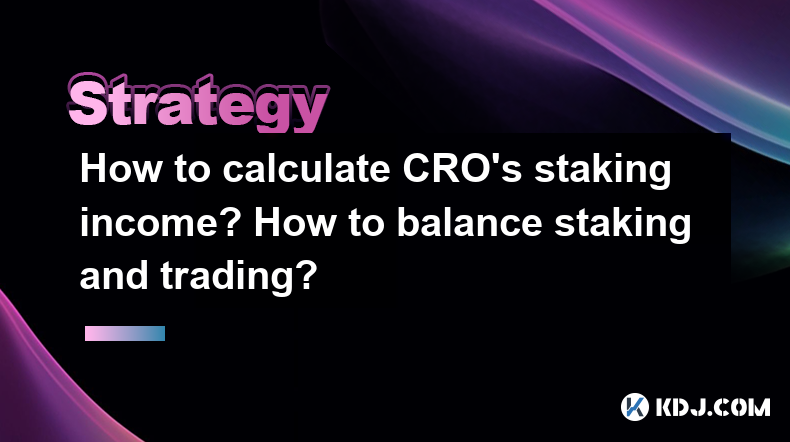-
 bitcoin
bitcoin $124586.364639 USD
0.62% -
 ethereum
ethereum $4670.671710 USD
3.33% -
 xrp
xrp $2.983701 USD
0.18% -
 tether
tether $1.000175 USD
-0.03% -
 bnb
bnb $1209.430642 USD
2.76% -
 solana
solana $231.365861 USD
0.51% -
 usd-coin
usd-coin $0.999665 USD
-0.02% -
 dogecoin
dogecoin $0.264657 USD
4.46% -
 tron
tron $0.346415 USD
1.60% -
 cardano
cardano $0.871586 USD
3.70% -
 chainlink
chainlink $23.451270 USD
7.56% -
 hyperliquid
hyperliquid $46.860071 USD
-2.96% -
 ethena-usde
ethena-usde $1.000120 USD
0.04% -
 sui
sui $3.611279 USD
1.08% -
 stellar
stellar $0.407149 USD
0.96%
How to calculate CRO's staking income? How to balance staking and trading?
To calculate CRO staking income, use the formula: Staking Income = (Amount Staked * APY) / 100. Balance staking with trading by diversifying your portfolio and monitoring market trends.
May 04, 2025 at 04:42 am

When it comes to the world of cryptocurrencies, understanding how to maximize your returns is crucial. One popular method for earning passive income in the crypto space is through staking, particularly with Crypto.com's native token, CRO. However, many investors also engage in trading to amplify their gains. This article will delve into how to calculate CRO's staking income and how to balance staking with trading to optimize your crypto portfolio.
Understanding CRO Staking
CRO staking is a process where you lock up your CRO tokens to support the operations of the Crypto.com network, and in return, you receive rewards. These rewards can be in the form of additional CRO tokens, which can be quite lucrative depending on the amount staked and the duration of the stake.
To begin staking CRO, you need to have a Crypto.com account. Once you have your account set up and funded with CRO, you can navigate to the staking section within the platform. Here, you will see various staking options, each with different lock-up periods and reward rates.
Calculating Staking Income
Calculating your potential staking income from CRO involves a few key variables: the amount of CRO staked, the annual percentage yield (APY), and the duration of the stake. The formula to calculate your staking income is relatively straightforward:
Staking Income = (Amount Staked APY) / 100
For example, if you stake 10,000 CRO at an APY of 10%, your annual staking income would be:
Staking Income = (10,000 10) / 100 = 1,000 CRO
It's important to note that the APY can fluctuate based on the overall health of the Crypto.com ecosystem and market conditions. Therefore, always check the current APY before calculating your expected returns.
Factors Affecting Staking Income
Several factors can affect your CRO staking income. These include:
- Staking Period: Longer staking periods often come with higher APYs. For instance, staking CRO for 3 months might yield a lower APY than staking for 6 months or a year.
- Amount Staked: Larger stakes can sometimes qualify for higher reward rates. Crypto.com may offer tiered rewards where the more you stake, the higher the APY.
- Market Conditions: The value of CRO can fluctuate, affecting the real-world value of your staking rewards. If CRO's price increases, your staking income in fiat terms will be higher.
Balancing Staking and Trading
Balancing staking and trading is essential to maximize your returns while managing risk. Here are some strategies to consider:
- Diversify Your Portfolio: Allocate a portion of your CRO to staking for passive income, and another portion for active trading. A common strategy might be to stake 70% of your CRO and use 30% for trading.
- Monitor Market Trends: Keep an eye on the market trends for CRO. If you believe the price will rise significantly in the short term, you might want to reduce your staking allocation and increase your trading activities.
- Liquidity Needs: Consider your liquidity needs. Staking often involves locking up your tokens for a set period, so ensure you have enough liquidity for trading and other expenses.
Implementing a Staking and Trading Strategy
To effectively implement a strategy that balances staking and trading, follow these steps:
- Assess Your Risk Tolerance: Determine how much risk you are willing to take. Staking is generally less risky than trading, so your allocation should reflect your comfort level with risk.
- Set Clear Goals: Define what you want to achieve with your CRO. Are you looking for steady passive income, or are you aiming for higher returns through trading?
- Use Tools and Platforms: Utilize tools like trading bots and analytics platforms to make informed decisions. For instance, Crypto.com's app provides insights and tools that can help you manage both staking and trading activities.
- Regularly Review and Adjust: The crypto market is dynamic, so it's crucial to regularly review your strategy and adjust your allocations as needed. This might mean moving some CRO from staking to trading or vice versa based on market conditions and your performance.
Practical Example of Balancing Staking and Trading
Let's consider a practical example to illustrate how to balance staking and trading with CRO:
- Initial Allocation: You have 10,000 CRO and decide to stake 7,000 CRO (70%) for a year at an APY of 10%, and use the remaining 3,000 CRO (30%) for trading.
- Staking Returns: Your staking income for the year would be 700 CRO.
- Trading Strategy: You use technical analysis and market trends to trade your 3,000 CRO. Let's say you manage to increase this portion by 20%, resulting in an additional 600 CRO.
- Total Returns: Your total return for the year would be 1,300 CRO (700 from staking + 600 from trading), which represents a 13% return on your initial 10,000 CRO.
FAQs
Q: Can I withdraw my staked CRO before the staking period ends?A: With Crypto.com, the ability to withdraw staked CRO before the staking period ends depends on the specific staking product you choose. Some products allow for early withdrawal with a penalty, while others do not permit early withdrawal at all. Always review the terms and conditions of the staking product before committing your CRO.
Q: How often are staking rewards distributed?A: Staking rewards for CRO are typically distributed on a weekly basis. However, the exact frequency can vary depending on the staking product you are using. Check the details of your specific staking product to understand the reward distribution schedule.
Q: What happens to my staked CRO if the price of CRO drops significantly?A: If the price of CRO drops significantly, the value of your staked CRO and your staking rewards in fiat terms will decrease. However, the number of CRO tokens you receive as staking rewards remains the same. It's important to consider the potential for price volatility when deciding how much to stake.
Q: Is there a minimum amount of CRO required to start staking?A: Yes, Crypto.com has a minimum staking requirement, which can vary depending on the staking product. For example, some products might require a minimum of 5,000 CRO to start staking. Always check the specific requirements for the staking product you are interested in.
Disclaimer:info@kdj.com
The information provided is not trading advice. kdj.com does not assume any responsibility for any investments made based on the information provided in this article. Cryptocurrencies are highly volatile and it is highly recommended that you invest with caution after thorough research!
If you believe that the content used on this website infringes your copyright, please contact us immediately (info@kdj.com) and we will delete it promptly.
- BlockDAG, DOGE, HYPE Sponsorship: Crypto Trends Shaping 2025
- 2025-10-01 00:25:13
- Deutsche Börse and Circle: A StableCoin Adoption Powerhouse in Europe
- 2025-10-01 00:25:13
- BlockDAG's Presale Buzz: Is It the Crypto to Watch in October 2025?
- 2025-10-01 00:30:13
- Bitcoin, Crypto, and IQ: When Genius Meets Digital Gold?
- 2025-10-01 00:30:13
- Stablecoins, American Innovation, and Wallet Tokens: The Next Frontier
- 2025-10-01 00:35:12
- NBU, Coins, and Crypto in Ukraine: A New Yorker's Take
- 2025-10-01 00:45:14
Related knowledge

Practical parameter settings for a Bitcoin multi-timeframe moving average system
Sep 18,2025 at 10:54pm
Optimizing Timeframe Combinations for Bitcoin Trading1. Selecting appropriate timeframes is crucial when building a multi-timeframe moving average sys...

How can I filter out false breakouts in Dogecoin high-frequency trading?
Sep 22,2025 at 01:00am
Understanding False Breakouts in Dogecoin Trading1. A false breakout occurs when Dogecoin's price appears to move beyond a defined support or resistan...

Techniques for identifying tops and bottoms in the Bitcoin on-chain NVT model
Sep 20,2025 at 07:54pm
Understanding the NVT Model in Bitcoin Analysis1. The Network Value to Transactions (NVT) ratio is often described as the 'P/E ratio' of the cryptocur...

What does the surge in open interest in Bitcoincoin futures mean?
Sep 20,2025 at 11:18pm
Understanding the Surge in Dogecoin Futures Open Interest1. A surge in open interest within Dogecoin futures indicates a growing number of active cont...

How can I use the Ethereum USDT premium to gauge market sentiment?
Sep 18,2025 at 11:55pm
Understanding the Ethereum USDT Premium1. The Ethereum USDT premium refers to the price difference between USDT (Tether) traded on Ethereum-based plat...

What should I do if Ethereum staking yields decline?
Sep 20,2025 at 06:18am
Understanding the Causes Behind Declining Ethereum Staking Yields1. The Ethereum network transitioned to a proof-of-stake consensus mechanism with the...

Practical parameter settings for a Bitcoin multi-timeframe moving average system
Sep 18,2025 at 10:54pm
Optimizing Timeframe Combinations for Bitcoin Trading1. Selecting appropriate timeframes is crucial when building a multi-timeframe moving average sys...

How can I filter out false breakouts in Dogecoin high-frequency trading?
Sep 22,2025 at 01:00am
Understanding False Breakouts in Dogecoin Trading1. A false breakout occurs when Dogecoin's price appears to move beyond a defined support or resistan...

Techniques for identifying tops and bottoms in the Bitcoin on-chain NVT model
Sep 20,2025 at 07:54pm
Understanding the NVT Model in Bitcoin Analysis1. The Network Value to Transactions (NVT) ratio is often described as the 'P/E ratio' of the cryptocur...

What does the surge in open interest in Bitcoincoin futures mean?
Sep 20,2025 at 11:18pm
Understanding the Surge in Dogecoin Futures Open Interest1. A surge in open interest within Dogecoin futures indicates a growing number of active cont...

How can I use the Ethereum USDT premium to gauge market sentiment?
Sep 18,2025 at 11:55pm
Understanding the Ethereum USDT Premium1. The Ethereum USDT premium refers to the price difference between USDT (Tether) traded on Ethereum-based plat...

What should I do if Ethereum staking yields decline?
Sep 20,2025 at 06:18am
Understanding the Causes Behind Declining Ethereum Staking Yields1. The Ethereum network transitioned to a proof-of-stake consensus mechanism with the...
See all articles










































































